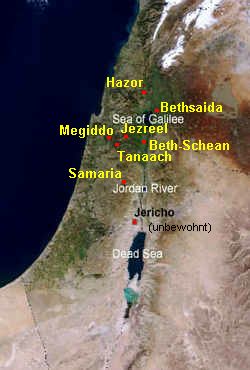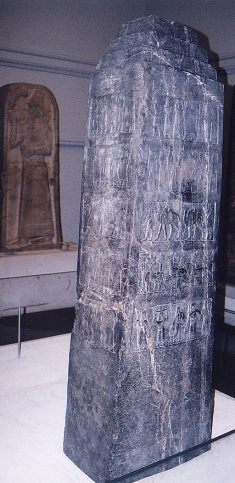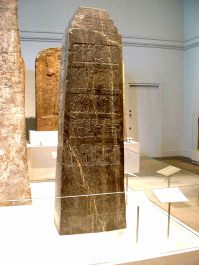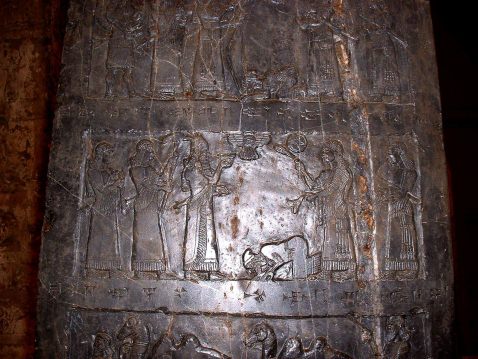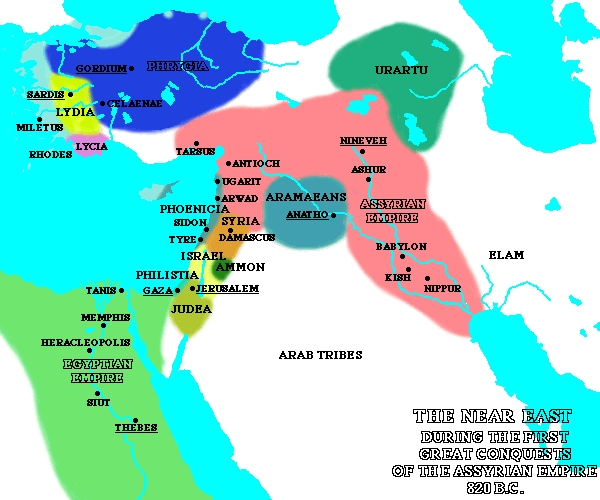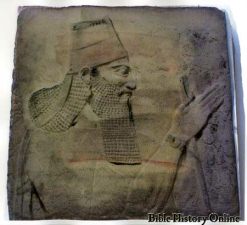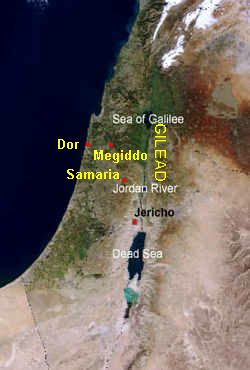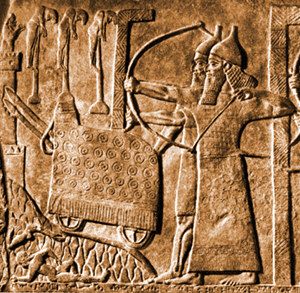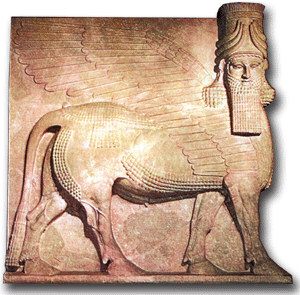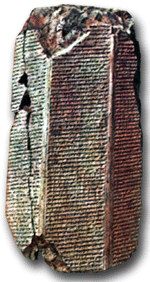

<< >>
Jewry: Fake and truth in the Old Testament (OT) according to documents and excavations
New identity by new Jewish history by help of chronology and archaeological research
27. North Reich between Omrid dynasty and Assyrian occupation 842-720 B.C. - destruction of northern kingdom of Israel
by Michael Palomino (2006 / 2010)
| Share: |
Facebook |
|
Twitter
|
|
|
|
from: Israel Finkelstein / Neil A. Silberman: The Bible unearthed. Archeology's New Vision of Ancient Israel and the Origin of Its Sacred Texts; The Free Press, a division of Simon & Schuster, Inc., 2001; German edition has got the title "No trombones before Jericho" (orig. German: "Keine Posaunen vor Jericho"): edition C.H.Beck oHG, Munich 2002;
Here in this analysis is used the German version "Keine Posaunen vor Jericho" of DTV, Munich 2004, second edition of 2005. All page indications refer to the German version. I hope the page numbers are not very different.
Assyria is standing before the city gates...

Map: Israel, Judah, Aram Damascus, Phoenicia, Ammon, Moab, Edom.
-- Moab is independent from Israel since 843 B.C.
-- territories in a light red are occupied by Assyria from 850 to 722 B.C. (occupied are Aram Damascus and Phoenicia)
-- the yellow territories are occupied by Assyria in 722-721 B.C., kingdom of Israel
-- territories drawn in a dark red are territories devastated by Nebuchadnezzar in 587-586 B.C. (kingdom of Judah).
The documents and the excavations of the time under king Jehu speak: there was an invasion of Aram Damascus under king Hazael in northern Israel
OT claims:
-- OT invents an "disloyalty to God" finding a cause for suffering, expropriation and at the and a ban
-- for the collapse of the North Reich of Israel there is invented an disloyalty to the temple in Jerusalem, and this disloyalty would have had provoked one catastrophe after the other and by this the self destruction of the Reich of Israel would have had favored
[whereas there cannot be found any remnants of the temple of Jerusalem for the Omrid period]
-- there is said that alleged prophets had warned in vain of an disloyalty to the temple of Jerusalem
-- there is said that the invasion of foreign armies and the devastation of the North Reich of Israel had been a part of a divine theological plan (p.216).
The archaeologists believe for a long time in a continuity without developments and by this neglect any investigation. Proofs for great changes and military defeats have not been taken earnest for a long time (p.220).
The northern Reich of Israel under the Omrids develops a prosperous society with all it's strong sides, weak sides, and tensions, and the wealth of the "North Reich of Israel" is attractive for certain elements in Assyria (p.216).
[Addition: Independence in this region is a big exception
Considering the geographic position of Israel and Judah as a territory which is always fiercely disputed between the great Empires of Mesopotamia and Egypt, so an independence seams to be a great exception, and it was a big exception that there was any independence for a certain time at all].
842-814 B.C.
Northern Reich of Israel with king Jehu: There comes an invasion under Hazael
OT claims:
-- idolatry under the king Jehu had risen on and on
-- also king Jehu is said never having considered Jerusalem as a cult center.
Well, according to archeology Jerusalem was no town until this point of time and there was no temple at all then...
-- king Jehu is said - as a "good deed" - having performed a cleansing against the cult of Baal organizing a Baal festival and encircling the visitors an slaughtering them, and the temple of Baal is said having converted into a "latrine" respectively a toilet complex (2d book of Kings, 10,18-28)
-- but king Jehu is said having continued with the "sins of Jerobeam" going on adoring the golden calves in Bethel and Dan (2d book of Kings 10,29): The own centers of cults are not eliminated, so that the competition to Jerusalem is going on (p.217).
But according to archeology Jerusalem was not at all a center of any cult in this time...
-- Got is said having uttered the prophecy to king Jehu that from his gender will rule only four generations (2d book of Kings, 10,30) (p.218)
-- the plan of God shall be that the northern kingdom of Israel should be punished by an invasion of Aram Damascus: king Hazael of Aram Damascus is said having defeated the Israeli armies in the East Bank and in the coastal plain (2d book of Kings, 10,32-33; 12,17-18; 13,3,7,22) (p.217)
-- according to OT this is the first invasion against Israel since the conquest under Joshua (p.222)
-- the territories of the northern Reich of Israel are said having been reduced by the occupation under Hazael
-- and the normal population is said having kept loyalty to God (2d book of Kings 13,23) (p.217).
According to the stele of Dan already king Jehoram is killed by king Hazael (p.221), and Hazor and Dan are said having belonged initially to Aram [the country of the Arameans] (p.224). The occupation of the town of Dan under king Hazael comes in 835 B.C. (p.196-197). According to the stele of Dan these invasions were weakening Israel decisively (p.221).
Assyrian sources also give a report about the invasion of king Hazael in the West and in the South down to the northern kingdom of Israel. Hazael can perform this invasion only because Assyria is occupied with own rebellions in its interior (p.225).
Hazael replaces Sheshonk
When there is considered a dating of Solomon the invasion of Hazael with it's destructions cannot be found in the layers (p.221). But when one considered the changing of dating with the allocation to the Omrids - considering that the city gates are not from the invented Solomon but from the Omrids, so all data get their correction: Not Sheshonk was the destructive force at the end of 10th century B.C., but Hazael was it in 835 B.C. (p.223). In this way many layers of destruction can be explained in the town hills. The new dating lets fall the layers of destruction to Hazael (p.223).
Map with Beth Shean, Rehov, Megiddo and Taanach, satellite photo.835-806 B.C.
The destruction of northern Reich Israel north of Samaria by the invasions of Hazael from Aram Damascus
As always the wars are for fertile soil for agriculture in the western "crescent":
-- king Hazael has the Aramean territories in the East Bank occupied
-- king Hazael has some of the most fertile agricultural regions of Israel devastated (p.222) with pillage of the rich valleys in the North, the valleys from Tel Rehov to Beth Shean, Taanach and Megiddo (p.223)
-- also great Israeli administration centers in the plain of Jezreel are destroyed, eventually also the town Jezreel itself (p.222)
-- king Hazael has the trade routes interrupted (p.222).
Some locations never recover completely again (p.223). But all in all the armies of Hazael can only destroy the region, but cannot perform an occupation (p.223).
[And as it seems Samaria is kept untouched. The invasive armies can be stopped before].
But according to new archeology Aram Damascus under king Hazael 835-800 B.C. can occupy decisive territories at the end:
-- the upper Jordan valley
-- and key territories in the North of northern kingdom of Israel (p.222).
The period without population in some towns
Map with Beth-Shean, Megiddo, Jezreel, Tanaach and Samaria.The regions of the plain of Jezreel and the region of the bay of Beth Shean have no populations for some decades and are running down (p.223). Megiddo for example, the administrative center in the North of the northern Reich is kept lost for almost 50 years (p.223-224). So, there was possible a destruction of this region, but there was no annexation. The towns of Jezreel and Taanach never reach their significance they had before (p.223).
Fortification works under king Hazael of Amar Damascus
Amar Damascus achieves putting forward it's borderline (p.224), and this borderline receives it's border marks:
Fortress of Dan: Hazael's victory stele of Dan indicates that Dan was occupied as it seams and the victory stele was erected only when the town was totally reconstructed presenting the dominance in that spot. Dan is reconstructed immediately, with massive town walls. There is an Aramean cult with a horned god now probably (p.224).
Fortress of Hazor: Hazor also is reconstructed immediately because this strategic center should function. On the acropolis was built a new town, with a new massive town wall, with a new palace or citadel, and eventually only now the big water system is installed. There is an Aramean cult with a horned god now probably (p.224).
Fortress of Bethsaida: The fortress at the Lake of Gennesaret is reconstructed. Archeology can find a basalt stele there with a picture of a horned god, probably from the Aramean culture (p.225).
According to archeology the populations are Aramean before and after the occupation by Aram Damascus. There is no settlement of foreign deportees (p.225).
Jehu gets the status of a vassal and has to bow himself to king Shalmaneser III on the "black obelisk"
King Jehu also is painted on the "black obelisk", the obelisk of the main chef of Mesopotamia, the Assyrian king Shalmaneser III. Jehu is presented in a position of a deep bow before Shalmaneser, and has to pay tributes which are counted by Shalmaneser:
The text of the stele: "I got from him silver, gold, a golden bowl, a golden vase with a pointed bottom, golden cups, golden buckets, tin, a stick for a king." (p.226)
So, northern Reich of Israel is a vassal of Syria now (p.226).
Map: Assyria, Syria and Israel in 820 B.C.
814-800 B.C.
Northern Reich of Israel under king Jehoahaz
OT claims: Jehoahaz is a son of Jehu (p.217)
Documents and archeology for the time of king Jehoahaz say: Assyria is occupying Syria - and Israel is recovering
According to the documents and to archeology Syria is now directly occupied, and Israel can recover from the occupation of Aram Damascus and a new period of growth can begin. The Bible is concealing this.
Details:
811-783 B.C.
Enthronement of Adad-Nirari III in Assyria
(p.225)
since 806-770 B.C.
The son of Hazael, Benhadad III, probably sieges Samaria
Benhadad III probably has continued with the invasions against northern Reich of Israel, at the end with a siege of Samaria. According to Finkelstein / Silberman the dates of the Bible with its indication of a siege of Samaria in the time of the kings of Ahab and Jehoram is much too early (p.223).
When there was an occupation of Samaria, so it could be that the core land of northern Rich of Israel has been suffered an Aramean Syrian occupation for some time (p.223).
The relation to Hazael is only possible with a change of dating from the Solomon allocation to an Omrid allocation (p.223).
803 appr.
Assyria destroys Aram Damascus - and this means a recovery for Israel
-- Adad-Nirari III of Assyria is renewing the pressure and has Damascus besieged
-- Barhadad III of Aram Damascus has to surrender and has to pay a high tribute to Assyria
-- with this Israel is liberated from the pressure of Damascus and gets new possibilities for new, own developments (p.225).
Archeology can confirm this development (p.226).
The events according to the reproaches of the historians of the OT, that there was a "godlessness" which caused the occupation, and that there was a "mercy" provoking the liberation, is an absolute fake and finds its explanation by the events in the neighbor states (p.226).
800-784 B.C.
Northern Reich of Israel under king Jehoash: reconquests
OT claims:
-- king Jehoash is said having organized new expansions and had occupied the towns of Aram Damascus (2d book of Kings, 13,25) (p.217)
-- king Jehoash is said having organized a punitive action against Judah (p.218).
Documents say about king Jehoash: There is a new rise and there are reconquests
But the historian of the OT describing the political change and stating the reason of God's mercy has forgotten some documents as it seems: Israel becomes the most favored vassal, and in the northern Reich of Israel wealth is growing again (p.226).
788-747 B.C.
Northern kingdom of Israel under king Jeroboam II
OT claims:
-- king Jeroboam II is said having ruled in peace in Samaria (p.218)
-- he is said having organized more expansions (2d book of Kings, 14,25 and 28)
-- but all "sins" are said having continued which had committed the "first Jeroboam" because the holy places of the "northern Reich" are maintained (p.218)
-- and the prophets Amos and Hosea allegedly are said having warned of disloyalty to God (p.218).
But according to archeology Jerusalem does not exist yet...
Alleged corruption under Jeroboam II: there are charges of the God's prophets Amos and Hosea - and there comes a "1 god movement" with texts of prophets
OT claims:
There are God's prophets protesting against luxury. These are recordings of the prophets Amos and Hosea, and they have survived originally. These texts claim a big corruption and a godless aristocracy how the upper class is organizing luxury by corruption (p.233).
Amos and Hosea - like Elia and Elisha - represent a "1 god belief". They insist that only one single god should be adored (p.268).
Amos and Hosea also present the idea of a revenge of God, and this idea will be imprinting after the ruin of the northern Reich of Israel in the ideology of Deuteronomy in southern Reich Judah (p.233).
God's prophet Amos: According to the book of Amos he is a shepherd from the Jewish village of Tekoa and is changing his domicile from the southern to the northern Reich. His oracles are a sharp damnification of luxury and of materialistic northern Reich of Israel (book of Amos 6,4-6) (p.233).
God's prophet Hosea: Hosea deplores lies and violence increasing daily, and deplores the alliance with Assyria and the trade policy with Egypt (book of Hosea 12,2) (p.233).
Amos and Hosea are denouncing
-- cases of social injustice
-- idolatry
-- inner tensions by international trade
-- the dependence from Assyria ("Assur")
-- the simulation of following religious laws, but every day there are bad actions and richness is compiled, and the poor are defamed (p.234).
The new 1 god movement
According to Finkelstein / Silberman the followers of Amos and Hosea represent the origin of the "1 god movement" (p.268). Their followers beware the texts of the prophets (p.234) with the sermons against injustice in the northern Reich of Israel. These texts are the base of the "1 god movement" (p.268). The movement is waiting for the collapse of the northern Reich of Israel. After the collapse of the state they want to take action against wealth and against foreign kind of living and against foreigners [in a racist way] (p.234).
[Addition: these prophets have a senseless and racist thinking of scapegoats
Stupidity blaming certain groups of humans for situations of tensions of for the "collapse" of a state is obvious: Foreign belief is said to be the cause of certain bad states of affairs. But bad states of affairs are not cleared by intolerance, but by change of structure in the state's apparatus. This fault also is committing "Christianism" later against the Jews, or movements in Asia against the Chinese, in the "USA" the white racists against Chinese and against Japanese etc.].
Documents and archeology speaking about the time of king Jeroboam II: There is an expansion and wealth and much corruption
Reconquests under Jeroboam II
Assyria accepts the Israeli reconquest of the East Bank:
Wealth under Jeroboam II: Population boom, strong army, and architecture
-- king Jeroboam II organizes the reconquest on far Aramean territories (p.227)
-- in Dan the victory stele of Hazael is destroyed and the pieces are used for the construction of Israeli buildings where they are found 2000 years later by archaeologists and are composed again (p.227)
-- in Bethsaida the Israelites find a stele with a horned god in Aramaic style turning this stele by 180 degrees and installing it on it's top (p.227)
-- Hazor is destroyed by the Israeli troops and then is reconstructed in an Israeli style, whereas here can be states Hebrew inscriptions the first time (p.227).
Wealth under king Jeroboam II
King Jeroboam II can compile a "wealth beyond example" (p.226). The royal dynasty under Jeroboam II has a cosmopolitan political line (pl.232-233). It's Israeli aristocracy is compiling a great richness and is living in a great luxury. For example furniture in the king's palace have got ivory elements (p.232). Writing and reading is widespread and by this also a bureaucratic administration and a professional army are possible. And economy is specializing (p.233).
Historiographers of OT declare that this wealth would be a sudden "mercy" of God without mentioning the collapse of Aram Damascus (2d book of Kings 14,26-27).
But the facts do not at all indicate a certain "mercy of God", but there are real capital concerns between Assyria and Israel because it can be admitted that Israeli economy can take part in the Assyrian world wide economy and by this there was new streams of cash (p.227).
Wealth under Jeroboam II: Export of olive oil and wine
King Jeroboam II develops a strong economy and a strong agriculture with a specialized industry of olive oil. There is a great growth of the population and new villages and towns are founded on cliffs in regions with olive cultures. In olive farms are founded specialized villages. Olive miles are installed in the rocks and other machinery is installed processing the olives, installed in the rocks. The olive oil is exported to Assyria and to Egypt, with high profits, because in Assyria and Egypt the conditions for the cultivation of olives are missing (p.227).
In the same manner is installed the cultivation of vineyards (p.227-228).
The explosion of the population in the agricultural interior is going on up to the end of the 8th century B.C. According to area-wide archeology and ethnographic estimation the region of the northern kingdom of Israel becomes the region with the densest population of wholeFertile Crescent (p.228).
[Addition: Probably the profits by olive oil and wine were that great so many persons were attracted from abroad, or there were special laws for big families].
The population boom also is the the base for the troops and for building activity, for the reconstruction of Megiddo, Hazor, Geser (strategical an important town on the border line to Philistine) etc. (p.229).
It seems that the historian of the OT had assigned this building activity under Jeroboam II to the faked Solomon (p.229-230).
Under king Jeroboam II first king's seals are produced (found in Megiddo in the 20th century) with a yelling lion and with Hebrew inscriptions, whereas the logos of the seals with a lion are typical for the 8th century and by this it can be excluded that they are from Jeroboam I of a time before (p.229).
Speculation about buildings in Megiddo similar to cattle sheds
According to the new manner of dating with the Omrids the buildings similar to cattle sheds in Megiddo were built under Jeroboam II. There is no purpose found until today because no remnants of animals have been found. The claim that the buildings were a center for horse breeding for the export of horses as war material seems to be nothing but a speculation. But Assyria mentions the exportation of horses by it's vassal states (p.231) as it has happened for example in Anatolia in the vassal state of Urartu where similar buildings could be found (p.232).
Southern Reich of Judah is envying the wealth in northern Reich of Israel
According to Finkelstein / Silberman it can be admitted that the population in Judah (Jerusalem) knew about the wealth under Jeroboam II and there was a certain envy (p.229).
747 B.C.
Death of Jeroboam II - the northern Reich of Israel is mentally empty
The structure of northern Reich of Israel is mentally empty. [It seems that Jeroboam II has not arranged an order of succession]. Finkelstein / Silberman admit that after the death of Jeroboam II groups in the administration were formed, with high militarists and mafia. Many kings are following being murdered after relatively short time by upheavals (p.234). At the same time there are massive changings in the Mid East (p.234-235).
[Assyria is preparing the ocupation of the northern Reich of Israel because it's not stable any more. Therefore the collapse of teh northern Reich of Israel does not at all come from God and not at all is a singular case. Southern Reich of Judah is not affected by the invasion because the traffic routes are very steep and the position is not so favorable not blocking any traffic routes].
747 B.C.
Northern Reich of Israel: king Zechariah, son of Jeroboam II
OT claims:
King Zechariah is said having ruled only for 6 months and then had been murdered by an envier. The alleged prophecy of God that only four generations of Jehu's gender will rule is allegedly fulfilled by this (p.218).
In that manner the Bible is "arranged"...
747 B.C.
Northern Reich of Israel under king Shallum
OT claims:
The murderer Shallum is said having ruled only for a short time and is said having been murdered by an envier Menahem, the son of Gadis (p.218).
747-737 B.C.
Northern Reich of Israel under king Menahem
OT claims:
-- God is said having prepared more punishments for northern Reich of Israel: the armament of Assyria and the extortion for tribute to Assyria
-- paying more tribute to Assyria Menahem is said having risen the taxed of the upper class: "50 silver shekel" (2d book of Kings 15,19-20)
-- northern kingdom of Israel has become absolutely instable, in it's inner and in it's policy of foreign affairs (p.218).
Documents and archeology speak: king Tiglath-Pileser III of Assyria
[other writings are also Tiglat Pileser, Tiglath-pilesar, Tiglatpilesar, Tiglat Pilesar].
745 B.C.
Assyria suffers a coup of power of Tiglath-Pileser III - and the vassals are controlled directly now
Tiglath-Pileser III is a brutal governor of the town of Kalach (Nimrud) in Tigris valley. Step by step he is converting Assyria into a brutal rogue state. The relations to the vassals are abrogated and the vassals are controlled directly (p.235).
Until now the activities of king Pekah are a mystery. He ends the surrendering policy to Assyria, perhaps by defiance because the tributes were too high. Pekah begins a game of power against Assyria with different coalitions, among others with king Rezin of Damascus or with the Philistine towns. King of Pekah and Rezin hope that a common resistance can be formed against the Assyrian aggression (p.235).
738 B.C.
Assyria: Military campaign of Tiglath-Pileser III against their ex vassals in the West
Now one ex vassal after the other is conquered by the Assyrian army and is extorted to tributes as never before. This is the beginning of a new Assyrian Empire. Step by step the ex vassals are occupied and the populations are deported (p.235).
Some time - only some pretext is needed - it's the turn of northern Reich of Israel. That is not any divine punishment, but this is military calculation...
737-735 B.C.
"Northern Reich of Israel" under king Pekahiah, the son of Menahem
OT claims:
-- king Pekahiah is said having been murdered in 735 B.C. by the officer Pekah
-- and Assyria is said having planned the occupation of Israel (p.218)
735-732
"Northern Reich of Israel" under king Pekah, son of Remalya
(p.235,239)
Documents and archeology speaking about king Pekah: A coalition with Damascus (under king Rezin) cannot be formed - and then follows the Assyrian occupation down to Samaria
But the coalition fails, and Tiglat-Pileser who is informed about these coalition plans is reacting with anger:
-- Tiglath-Pileser has Damascus occupied and king Rezin executed (p.235)
-- before the arrival of the invasion the fortification of Hazor for example is more fortified yet, but in vain, and then it is destroyed massively like also Dan and Beth-Shean (p.237)
-- Tiglath-Pileser is performing his military campaign up to the Mediterranean and than along the coast and has all rebellion towns destructed (p.235) interrupting the connection between the Middle East and Egypt (p.235-236)
-- the next step will be the occupation of a big part of northern Reich of Israel, and the most important towns are destroyed and the population is deported (p.236).
Of Megiddo only the residential districts are destroyed, but the stones of the column houses are reutilized for the construction of a first administration center and a new capital which will be the see of the governor (p.237).
In this case it seems that the OT and the facts are the same:
732 B.C.
According to OT Assyria under Tiglath-Pileser III is said having occupied the northern valleys and Galilee
The Assyrian occupations are: Jion, "Avel-Beth-Maacha, Janoah, Kedes, Hazor, Gilead and of Galilee the whole region of Naphthali" (2d book of Kings 15,29), and the population is allegedly deported (S.218).
Reich of Israel is said having lost a part of it's territories and is said having limited to the highlands of Samaria (p.219).
Old Testament is rating the occupation now as a moral "punishment of God": The faked prophecy of 1st Moses 15,18 with it's Israeli borderlines from Nile river to Euphrates river is said having been abolished by the "sins" committed before (p.219).
For this catastrophe king Pekah is said having been murdered by Hosea (p.219).
Documents and archeology speaking about the Assyrian occupation regime in ex northern Reich of Israel with the exception of Samaria region
Map with Dor, Megiddo, Gilead and Samaria
The ex Reich of Israel is parted in new provinces:
-- Dor (with the northern coast)
-- Megiddo (with the Jezreel plain and with Galilee)
-- Gilead (with the highlands of the East Bank) (p.236).
Here is a relief from the times of Tiglath-Pileser III showing the siege of Gaazru, probably Geser (p.236).
Tiglath-Pileser's army sieging Gazru with storm vehicles and bowmen
This gypsum relief is from the ancient Assyrian palace at Nimrud, the capital city, depicts the utter destruction of the city of Gazru by Tiglath-pilesar III’s mighty Assyrian army. It is now at the British Museum. Notice the powerful battering ram to bring down the walls, at the top left are three men who have been impaled on spiked poles [web01].
These population figures are estimations according to archaeological territorial research and demographic research:
From the northern Reich of Israel only remain the highlands of Samaria. Monumental inscriptions of Tiglath-Pileser III are testimony of these events, with a specialmention of the safed Samaria (p.236).
The deportations are used for the continuing development of the own Reich. Any destruction of a site and any deportation is one more an intimidation. Prisoners of war are drawn to military service, deported craftsmen are used for works in the center of the Assyrian Empire promoting wealth there (p.236). Settlements in empty regions are amplifying agriculture (p.237).
[Also Stalin did it like this...]
The chronological descriptions of Tiglath Pileser III mention 13.500 deported Jews. Archaeological investigations confirm the fact that whole sections of lower Galilee have been without any population for decades in this time (p.237).
Megiddo is reconstructed in an absolutely new lattice-like layout. At the left and the right side of the city gate palaces are built in a typical Assyrian style. The residential quarters are built in lattice-like blocks. This layout was unknown in Fertile Crescent until this time (p.237). Finkelstein / Silberman admit that in these block like residential quarters Mesopotamians were settled (p.240).
The Israelite "island" of Samaria
Samaria is spared of the Assyrian occupation for some time, but not for a long time any more (p.240).
732-724/722 B.C.
Northern mini kingdom of Israel under king Hosea: rebellion conspiracy
OT claims:
-- in Assyria king Shalmaneser V is said having taken the power and is said having installed an imperial policy
-- king Hosea is said having surrendered as a loyal vassal having offered tribute, but clandestinely had aimed for an alliance with Egypt for a successful rebellion
-- the Assyrian king Shalmaneser V is said having been informed of this maneuver of Hosea and then Hosea is said having been seized ant the rest of the northern Reich of Israel is said having been occupied whereas the occupation of Samaria is said having required three years of siege (p.219)
-- OT claims about king Hosea: Hosea "did what displeased to the Lord", but it was not so much than the other kings did before (2d book of Kings 17,2) (p.243).
Documents and archeology are speaking about king Hosea
End of 8th century appr. / 730 B.C. appr.
There are numbers of population according to Finkelstein / Silberman
-- mini northern kingdom of Israel has appr. 350,000 inhabitants
-- kingdom of Judah has almost 100,000 inhabitants
-- the kingdoms of Ammon and Moab together have appr. 100,000 inhabitants (p.229).
727 B.C.
Death of king Tiglath-Pileser III and interregnum with a weak period of Assyria - the trial of conspiracy of king Hosea with Egypt
King Hosea of Samaria means that he could start a rebellion in the weak time of Assyria after the death of Tiglath-Pileser when king Shalmaneser V is not enthroned yet. So, king Hosea has contacts made with the army of Egypt in the Nile Delta with the aim to arrange a coalition against Assyria hoping that Egypt will attack Assyria now. At the end king Hosea even stops it's tribute to Assyria (p.240).
The destructive campaign of Assyria under Shalmaneser V against mini northern kingdom of Israel - securing trade roads
The new king in Assyria, Shalmaneser V, is reacting against the rebellious conspiracy with a campaign of destruction against Samaria and with it's siege. It's not sure if Shalmaneser can see the storming yet (p.240).
At the same time the northern mini Reich of Israel is not only an "attractive goal" (p.245), but also the trade roads in the Middle East between Mesopotamia and the Mediterranean coast and Arabia have to be secured because otherwise they would be in Egypt hands affecting and destructing badly a big part of the Assyrian trade connections (p.288-290).
Successor in Assyria is king Sargon II, and the kingdom of Judah is not interesting with it's geographical isolated position is not interesting for him (p.250).
724 B.C.
Samaria with collapse, deportation and resettlement under king Shalmaneser V
OT claims:
-- the Assyrian king Shalmaneser V is said having sieged Samaria for 3 years
-- Shalmaneser V is said having deported the population to Halah and to Habor river in Gosan [Tell Halaf] and to the towns of the Medes (2d book of Kings 17,6)
-- the alleged 10 tribes of the North are said having eliminated by the deportations
-- Shalmaneser is said having settled people from Mesopotamia in the conquered northern Reich of Israel, people from Babel, Kutha, Awa, Hamath, and from Sepharwaim, above all in Samaria (2d book of Kings 17,24)
-- and now - in this way is claiming the OT - the "kingdom of Judah" is said to be obliged to redeem Israel from the occupation (p.219)
-- OT claims that the occupation of the whole northern Reich of Israel with it's invaders from outside had been a punishment for the "sin" of idolatry in the northern Reich (p.21).
The collapse of Samaria according to documents and archeology
In 722 B.C. Sargon II is enthroned in Assyria. It can be that Sargon II and not Shalmaneser V is witness of the storming of Samaria and executing the deportations. Sargon's chronicle is reporting in details about the prey with 27,280 persons, war chariots and with the gods of the population (p.240).
Assyria: Sargon II.
Sargon II, profile
This limestone relief of Sargon II comes from the town of Khorshabad (under Sargon called Dur Sharrukin) and has a height of tree feet. Here he has got a neo Assyrian crown. See the colored bands, the braided hears and beard, and the earrings. Today this relief is in the Egizio Museum in Turin [web02].
Sargon II: palace figures: winged horse with a human head
This winged being (Lamassu) was found in the palace of Sargon II in Dur-Sharrukin (today: Kohrsabad) on the right side of the entrance to the throne hall. The statue is 14 feet high. There were four such statues on each side and there were two head opposit to the other ones as if they would look to each other. There was the belief that Lamassu could safe the palace from demons. Today this statue is in the Oriental institute of Chicago [web03].
Sargon II, the inscripcion about the victory against Samaria and the deportations
The destroyed history of the northern Reich of Israel
With an Assyrian efficiency all facilities and documents are destroyed in Samaria so there is no historiography left with the point of view of northern kingdom of Israel (p.244).
Deportations from northern Reich of Israel: The OT speaks of "punishment"
The northern Reich of Israel is said having been destroyed as a punishment for isolatry, and the 10 faked tribes are said having banned to Mesopotamia (p.167).
Documents about the deportations
The Israelites are permitted the formation of a military unit of 200 war chariots integrated in the Assyrian army. The rest is deported to central Assyria, and Samaria itself is populated with new population from other occupated regions. All are rated as "Assyrians" now (p.240).
[In this way also Stalin acted...]
The faith of the deported Jews is kept in the dark. According Finkelstein / Silberman an assimilation can be admitted (p.241).
[Also Stalin did this with the Jews: "russification"].
According to the documents the deportations under Tiglath-Pileser III and under Sargon II include about 40,000 persons. So, a major part of the estimated 350,000 inhabitants can stay, and is seems that - according to Finkelstein / Silberman - there were "only" deported rebels and "precious craftsmen" (p.242).
Samaria is renamed as Samerina
Proud northern Reich of Israel has collapsed (p.241). Samaria province is renamed Samerina. Production of olive oil is going on, according to archeological investigation and research of demography the landscape is kept intact, and the villages keep all their population (p.242).
[Agriculture has to go on. Because of this it's not possible to deport the whole population. Assyria does not want to resign to olive oil and good wine...]
The new settlements according to the documetns and archeology
According to the findings there is not only newly settled people in Samaria (now called Samerina), but also in the strategically important region of Bethel, the old Israelitcenter of cult (p.241), and generally at the border to Judah (p.242), for example peolpe from Awa (Awim) (p.241).
[In this manner also tsarist Russia did it: Foreign peoples were settled in the border reagions, e.g. Jews at the border to East European states or in Birobidshan at the Chinese border].
|
|
|
Sources
[web01] http://www.bible-history.com/assyria_archaeology/archaeology_of_ancient_assyria_archaeological_discoveries.html
[web02] http://www.bible-history.com/assyria_archaeology/archaeology_of_ancient_assyria_archaeological_discoveries.html
[web03] http://www.bible-history.com/assyria_archaeology/archaeology_of_ancient_assyria_archaeological_discoveries.html
[web04] http://www.bible-history.com/assyria_archaeology/archaeology_of_ancient_assyria_archaeological_discoveries.html
Photo sources
-- map ot the kingdoms of Israel and Judah, and Philistine, Aram Damascus, Ammon, Moab, and Edom:
http://www-unix.oit.umass.edu/~juda102/images/indexquiz1.html http://www-unix.oit.umass.edu/~juda102/images/landofisrael.jpg
-- Shalmaneser III.: black obelisc with victory story about Samaria and Jehu:
http://www.adventjugend.at/forum/forum/topic.asp?TOPIC_ID=182
-- close up: http://truthchasers.com/assyria.htm; http://truthchasers.com/Photos/assyrian/DSCF0013.jpg
-- Jehu with Shalmaneser III., genuflection: http://www.geschichtsforum.de/showthread.php?t=4191;
http://www.uni-essen.de/Ev-Theologie/images/Jehu.jpg; http://truthchasers.com/assyria.htm
-- map with Assyria which has ocupated Syria:
http://www.utexas.edu/courses/classicalarch/images.html; http://www.utexas.edu/courses/classicalarch/images2/MapNeoassyrian.gif
-- map with Assyria in 820 B.C.: http://history-world.org/maps%20ancientworld.htm
-- Tiglath-Pileser III., Profil, Fundort Nimrud: http://www.bible-history.com/archaeology/assyria/Tiglath-Pileser-III.html
-- Tiglath-Pilesers army sieging Gazru with war chariot and bowmen:
http://www.bible-history.com/assyria_archaeology/archaeology_of_ancient_assyria_archaeological_discoveries.html
-- Sargon II., profile: http://www.geschichtsforum.de/showthread.php?t=4191; http://www.bible-history.com/assyria_archaeology/sargon_ii_portrait.jpg
-- Sargon II.: palace statues with winged horse and human head:
http://www.bible-history.com/assyria_archaeology/archaeology_of_ancient_assyria_archaeological_discoveries.html
-- Sargon II.: inscription about the victory against Samaria and the deportations:
http://www.bible-history.com/assyria_archaeology/archaeology_of_ancient_assyria_archaeological_discoveries.html
^
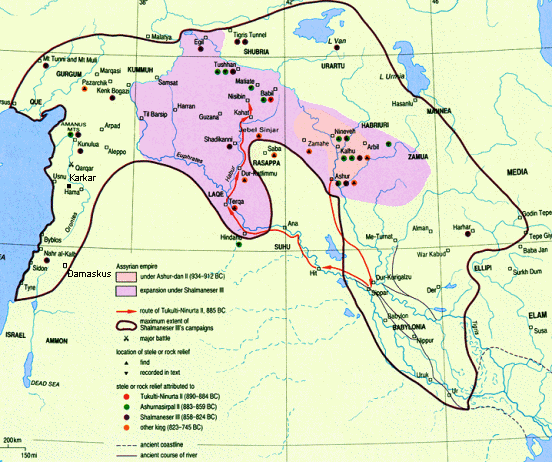
 Map of Assyria under
Shalmaneser III. This is a huge "half moon"...
Map of Assyria under
Shalmaneser III. This is a huge "half moon"...
